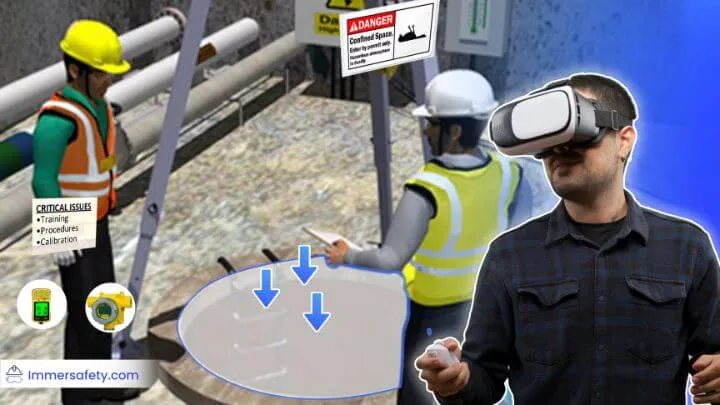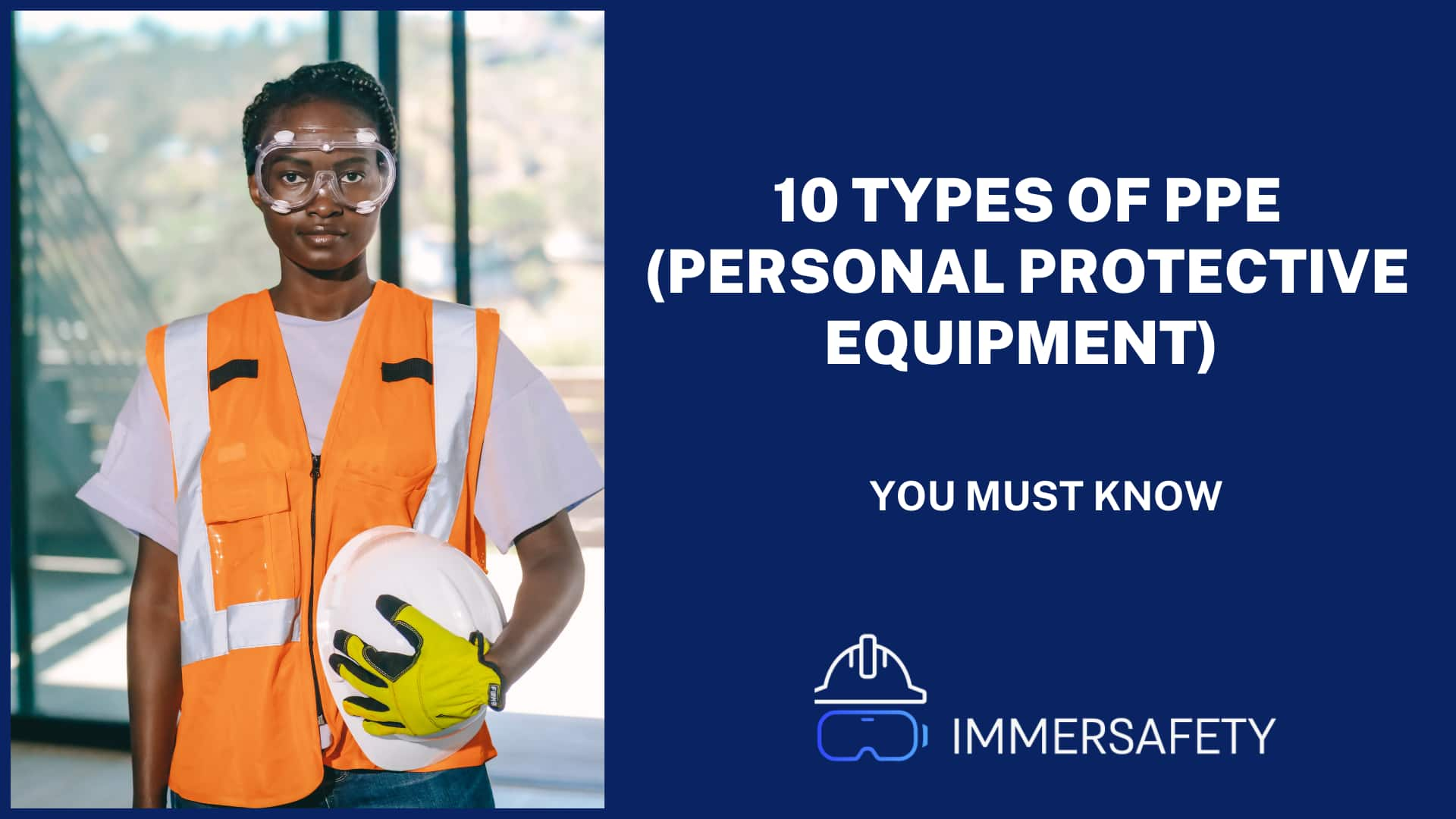Personal Protective Equipment (PPE) plays a vital role in ensuring the safety and well-being of workers across various industries.
PPE serves as a barrier between employees and workplace hazards, reducing the risk of injuries and illnesses.
In this blog, we will explore 10 different types of PPE that are essential for maintaining a safe and secure work environment.
10 Different Types Of PPE (Personal Protective Equipment) You Must Know
Certainly, here’s a detailed breakdown of each type of personal protective equipment (PPE) you’ve mentioned:
1. Head Protection: Hard Hats

Hard hats are designed to protect the head from various potential hazards, particularly in industries where there is a risk of falling objects, impacts, or electrical shocks. They consist of a rigid outer shell made from materials like high-density polyethylene and a suspension system inside to absorb and distribute impact forces. The suspension system helps create a cushioning effect and ensures a secure fit on the wearer’s head. Hard hats often have slots for attaching accessories like face shields, earmuffs, and headlamps. They are commonly used in construction, mining, manufacturing, and other industries where head injuries are a concern.
You’ll also like:
21 Safety Training Topics For Employees
2. Eye and Face Protection: Safety Glasses and Face Shields
Safety glasses are designed to protect the eyes from various hazards such as flying debris, chemicals, and particles. They often have impact-resistant lenses and frames that provide a comfortable fit and prevent objects from entering the eye area. Safety glasses can also have side shields for additional protection. Face shields, on the other hand, provide a clear plastic shield that covers the entire face. They offer protection against splashes, sparks, and intense light. Safety glasses and face shields are crucial in industries such as welding, construction, woodworking, and laboratories.
3. Hearing Protection: Earplugs and Earmuffs
Earplugs and earmuffs are used to reduce the risk of noise-induced hearing loss in environments with high noise levels. Earplugs are inserted into the ear canal to block or reduce noise, while earmuffs cover the entire ear and provide a seal to reduce noise exposure. Both options come in various levels of noise reduction and are chosen based on the noise level and the wearer’s comfort. Hearing protection is essential in industries like manufacturing, construction, mining, and aviation.
4. Respiratory Protection: Respirators
Respirators are designed to protect the wearer from inhaling hazardous airborne contaminants, including dust, fumes, gases, and pathogens. Different types of respirators are available, ranging from disposable N95 masks that filter out particles to more advanced options like powered air-purifying respirators (PAPRs) that provide a continuous flow of filtered air. Respirators are used in industries such as healthcare, construction, manufacturing, and agriculture to ensure workers breathe clean air.
5. Hand Protection: Gloves
Gloves provide protection for the hands against cuts, chemical exposure, burns, and abrasions. Different types of gloves are chosen based on the specific task and the type of materials being handled. For example, latex or nitrile gloves are often used in healthcare settings to protect against biological hazards, while leather gloves may be used in construction or welding to protect against heat and abrasion. Gloves are crucial in industries where hand injuries and exposure to harmful substances are common.
6. Body Protection: Coveralls, Aprons, and Full Suits
Coveralls, aprons, and full suits offer protection for the body against chemical spills, biological hazards, and other harmful substances. These garments are often made from specialized materials that are resistant to chemicals, liquids, and contaminants. They are commonly used in laboratory settings, cleanrooms, and industries dealing with hazardous materials such as chemicals or pharmaceuticals. Full suits may include integrated gloves and boots to provide comprehensive protection.
7. Foot Protection: Safety Boots and Shoes
Safety boots and shoes are designed to protect the feet from various hazards, including heavy objects, punctures, electric shocks, and chemical spills. They often feature steel or composite toe caps to provide impact protection, as well as rugged soles that offer slip resistance and additional protection against punctures. Safety footwear can be found in industries such as construction, manufacturing, mining, and agriculture, where foot injuries are common due to heavy machinery, tools, and materials.
8. Fall Protection: Harnesses and Lanyards
Fall protection equipment is crucial for preventing falls from heights and ensuring the safety of workers who perform tasks at elevated levels. Harnesses are worn around the body and are connected to lanyards or lifelines, which are anchored to secure points. In the event of a fall, the harness distributes forces across the body and prevents free-falling. This type of PPE is essential in industries like construction, roofing, tower climbing, and maintenance work conducted at heights.
9. High-Visibility Clothing: Reflective Vests
High-visibility clothing, often in the form of reflective vests, enhances the visibility of workers in low-light conditions or areas with moving machinery. These garments are typically brightly colored with reflective stripes, making it easier for others to see the wearer. High-visibility clothing is essential for workers in road construction, traffic control, airport operations, and any environment where visibility is critical to prevent accidents.
10. Chemical Protection: Hazmat Suits and Aprons
Hazmat suits (hazardous materials suits) and chemical-resistant aprons provide comprehensive protection against exposure to hazardous chemicals or substances. These suits are designed to create a barrier between the wearer and the potentially harmful agents. They often include features such as sealed seams, respirator compatibility, and self-contained breathing apparatus (SCBA) integration. Hazmat suits and chemical-resistant aprons are essential in industries involving emergency response, chemical handling, waste management, and research laboratories where exposure to dangerous substances is a concern.
Each of these types of PPE serves a specific purpose in ensuring the safety and well-being of workers across various industries. Proper training, selection, and use of the appropriate PPE are essential to mitigate risks and protect workers from potential injuries and health hazards.
Final Thoughts:
Personal Protective Equipment (PPE) is an integral component of workplace safety, providing a critical layer of defence against various hazards. From hard hats to hazmat suits, each type of PPE is designed to address specific risks and ensure the well-being of workers across diverse industries. By understanding and implementing the appropriate PPE, employers demonstrate a commitment to their employees’ safety and contribute to a safer, more secure work environment. Remember, the effective use of PPE, combined with proper training and adherence to safety protocols, is essential for a comprehensive approach to workplace safety.
Ready to embrace the future of safety education? Reach out for a demo and explore the benefits of VR Safety Training Solution.
FAQ’s
Certainly, here are five frequently asked questions (FAQs) related to Personal Protective Equipment (PPE) for safety:
1. Why is PPE important in the workplace?
PPE is crucial in the workplace because it helps protect workers from various hazards that could cause injuries, illnesses, or fatalities. It acts as a barrier between the worker and potential dangers, such as falling objects, chemicals, noise, and airborne contaminants. Properly selected and worn PPE can significantly reduce the risk of workplace accidents and ensure a safer working environment.
2. How do I choose the right type of PPE for my task?
Selecting the appropriate PPE involves assessing the specific hazards associated with the task or work environment. Start by identifying potential risks, such as impact, chemicals, noise, or biological agents. Consult safety guidelines, regulations, and equipment manufacturers’ recommendations to determine the right type of PPE. Consider factors like comfort, fit, and compatibility with other equipment. Training and guidance from safety professionals can also help in making the right choice.
3. When should I replace or upgrade my PPE?
PPE should be regularly inspected for signs of wear, damage, or degradation. If you notice any cracks, tears, or loss of effectiveness, the PPE should be replaced immediately. Additionally, PPE should be upgraded when new technologies or advancements provide better protection or comfort. Follow manufacturer guidelines and industry standards for replacement intervals and keep a record of inspections and replacements.
4. Is training necessary for using PPE effectively?
Yes, proper training is essential for using PPE effectively. Workers need to be educated on how to properly wear, adjust, maintain, and store their PPE. Training should cover the correct sequence for donning and doffing, as well as limitations and proper care. Moreover, workers should understand the hazards they are protected against and the importance of consistent PPE use. Training programs should be conducted regularly, especially when new equipment or procedures are introduced.
5. What is the role of employers in PPE provision?
Employers have a responsibility to provide appropriate PPE to their workers free of charge. This includes ensuring that PPE is suitable for the tasks and hazards at hand, conducting hazard assessments, and maintaining a safe work environment. Employers should also train workers on proper PPE use, supervise its correct application, and regularly evaluate the effectiveness of the PPE program. Communication, enforcement, and continuous improvement are key aspects of an effective PPE management system.


